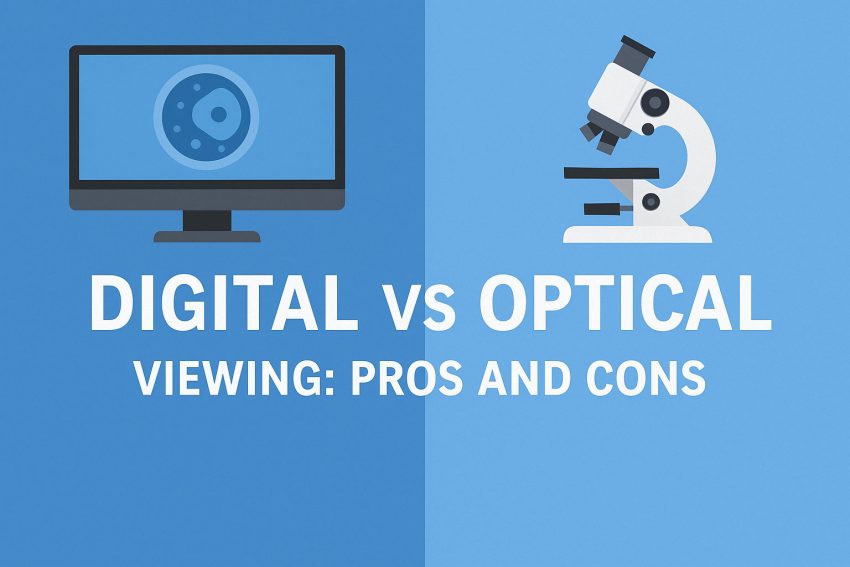Explore the pros and cons of digital vs optical viewing in modern microscopy and surgical imaging. Learn which system offers better clarity, ergonomics, collaboration, and diagnostic power.
In the field of microscopy and surgical imaging, a long-standing debate continues to evolve: digital viewing vs optical viewing. As technology advances, both systems offer distinct advantages and limitations, making it important for medical professionals, researchers, and technicians to understand which viewing method best suits their needs.
This article compares digital and optical viewing systems, examining their strengths, challenges, and ideal applications in fields such as surgery, diagnostics, education, and laboratory analysis.
What Is Optical Viewing?
Optical viewing refers to traditional microscope systems where the image is seen through an eyepiece using glass lenses. The light from the specimen passes through the optics, offering real-time, high-resolution, three-dimensional visualization directly to the user’s eye.
Common Features of Optical Viewing:
Real-time feedback with zero latency
True color fidelity and clarity
Depth perception through binocular vision
No need for electronic components
What Is Digital Viewing?
Digital viewing involves the use of cameras, sensors, and monitors to display magnified images of a specimen. Digital microscopes and surgical systems often project the image onto a screen in either 2D or 3D formats.
Common Features of Digital Viewing:
Real-time or near-real-time imaging on large monitors
Ability to capture, record, and analyze images
Integration with software for measurements, overlays, and AI-assisted diagnostics
Enhanced ergonomics with heads-up displays
Digital vs Optical: Key Comparison Areas
1. Image Quality & Depth Perception
Optical: Offers superior depth perception due to direct binocular vision. Optical lenses provide high clarity and resolution, particularly useful in surgical precision work.
Digital: Can match or exceed optical clarity with high-resolution sensors (e.g., 4K or 8K). However, digital 2D images lack natural depth unless enhanced with 3D visualization technology.
Winner: Optical (for natural depth); Digital (with 3D support)
2. Ergonomics and Comfort
Optical: Requires users to maintain eye contact with eyepieces, which can cause strain during long procedures or lab work.
Digital: Supports heads-up viewing on large monitors, allowing a more relaxed posture and reduced physical fatigue.
Winner: Digital
3. Collaboration and Teaching
Optical: Only one or two users can view at a time through eyepieces.
Digital: Allows multiple users to observe simultaneously on large screens, ideal for group training and team surgeries.
Winner: Digital
4. Documentation and Data Integration
Optical: Limited in documentation; images must be captured using external camera systems.
Digital: Built-in image and video recording, annotation, and seamless software integration for case archiving, presentations, or diagnostics.
Winner: Digital
5. Cost and Accessibility
Optical: Generally lower upfront costs and easier to maintain.
Digital: Higher initial investment and more complex setup; may require regular software and hardware updates.
Winner: Optical (for cost-conscious environments)
6. Latency and Real-Time Feedback
Optical: Zero latency—what you see is what’s happening in real time.
Digital: May introduce minor latency depending on the system, though modern platforms are improving rapidly.
Winner: Optical
Ideal Use Cases
| Application Area | Best Fit |
|---|---|
| High-precision surgery | Optical (or 3D Digital) |
| Teaching and training | Digital |
| Remote collaboration | Digital |
| Field or point-of-care use | Optical |
| Image analysis & AI tools | Digital |
The Future: Hybrid Systems
Many modern platforms now offer hybrid microscopes, combining both digital and optical capabilities. These allow users to switch between traditional eyepieces and digital displays, offering the best of both worlds.
With ongoing innovations in artificial intelligence, image processing, and augmented reality, digital viewing systems will continue to evolve—making them more accessible and powerful than ever before.
Conclusion
Choosing between digital and optical viewing depends on your specific needs, environment, and budget. Optical systems remain unparalleled in depth perception and latency, while digital systems provide unmatched ergonomic, collaborative, and analytical capabilities.
As the line between both technologies continues to blur, the key is understanding your goals—whether it’s surgical precision, collaborative learning, or integrated diagnostics.
